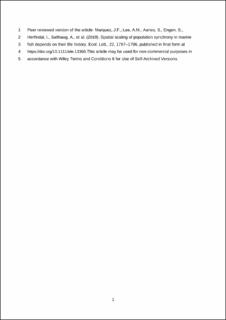| dc.contributor.author | Fredricson Marquez, Jonatan | |
| dc.contributor.author | Lee, Aline Magdalena | |
| dc.contributor.author | Aanes, Sondre | |
| dc.contributor.author | Engen, Steinar | |
| dc.contributor.author | Herfindal, Ivar | |
| dc.contributor.author | Salthaug, Are | |
| dc.contributor.author | Sæther, Bernt-Erik | |
| dc.date.accessioned | 2021-05-12T12:02:34Z | |
| dc.date.available | 2021-05-12T12:02:34Z | |
| dc.date.created | 2019-10-02T15:41:36Z | |
| dc.date.issued | 2019 | |
| dc.identifier.citation | Ecology Letters. 2019, 22 (11), 1787-1796. | en_US |
| dc.identifier.issn | 1461-023X | |
| dc.identifier.uri | https://hdl.handle.net/11250/2755184 | |
| dc.description.abstract | The synchrony of population dynamics in space has important implications for ecological processes, for example affecting the spread of diseases, spatial distributions and risk of extinction. Here, we studied the relationship between spatial scaling in population dynamics and species position along the slow‐fast continuum of life history variation. Specifically, we explored how generation time, growth rate and mortality rate predicted the spatial scaling of abundance and yearly changes in abundance of eight marine fish species. Our results show that population dynamics of species' with ‘slow’ life histories are synchronised over greater distances than those of species with ‘fast’ life histories. These findings provide evidence for a relationship between the position of the species along the life history continuum and population dynamics in space, showing that the spatial distribution of abundance may be related to life history characteristics. | en_US |
| dc.language.iso | eng | en_US |
| dc.publisher | Wiley | en_US |
| dc.relation.uri | https://figshare.com/articles/Spatial_data_and_life_history/8427212 | |
| dc.title | Spatial scaling of population synchrony in marine fish depends on their life history | en_US |
| dc.type | Peer reviewed | en_US |
| dc.type | Journal article | en_US |
| dc.description.version | acceptedVersion | en_US |
| dc.subject.nsi | VDP::Matematikk og naturvitenskap: 400 | en_US |
| dc.subject.nsi | VDP::Mathematics and natural scienses: 400 | en_US |
| dc.source.pagenumber | 1787-1796 | en_US |
| dc.source.volume | 22 | en_US |
| dc.source.journal | Ecology Letters | en_US |
| dc.source.issue | 11 | en_US |
| dc.identifier.doi | 10.1111/ele.13360 | |
| dc.identifier.cristin | 1733137 | |
| dc.relation.project | Norges forskningsråd: 244647 | en_US |
| dc.relation.project | Norges forskningsråd: 223257 | en_US |
| dc.description.localcode | This is the peer reviewed version of an article, which has been published in final form at [https://doi.org/10.1111/ele.13360]. This article may be used for non-commercial purposes in accordance with Wiley Terms and Conditions for Self-Archiving. " | en_US |
| cristin.ispublished | true | |
| cristin.fulltext | postprint | |
| cristin.qualitycode | 2 | |
